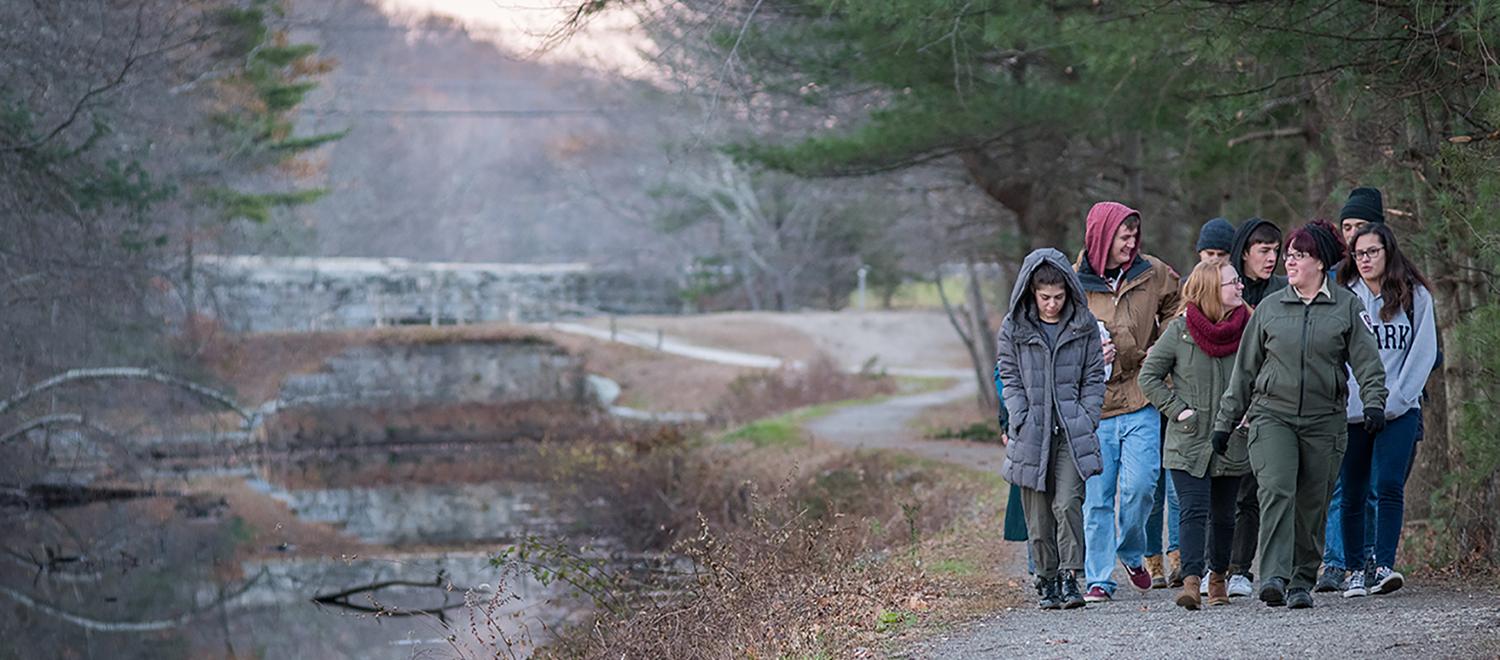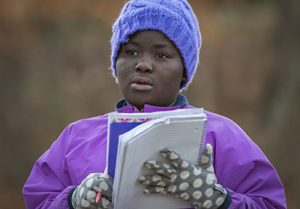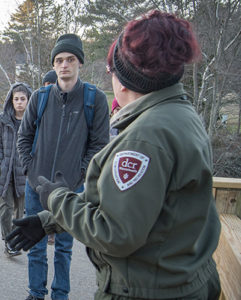First-year students explore significance of area’s waterways

When Aidan Giasson ’21 arrived at Clark University from Rockland, Maine, in fall 2017, she wasn’t yet sure about her academic interests. A First-Year Intensive (FYI) seminar with Associate Professor of Geography Rinku Roy Chowdhury, Ph.D.’03, helped Giasson sort that out.

In her first semester, Giasson took Roy Chowdhury’s course “Water and the City: A Socio-Hydrology of Worcester and its Environs,” which, like Clark’s 30 other FYI seminars, allows a small cohort of first-year students to explore a topic in depth. The course also met Clark’s Problems of Practice (POP) course requirements, connecting Giasson and her 11 classmates with Worcester and regional practitioners and policymakers.
“It’s a way to go deeper,” Roy Chowdhury says of POP courses, “allowing students to step outside of academia and see the relationship between what they’re studying in college, and the real world.”
For Giasson, “The class helped me discover what some of my true interests are. Coming to college I thought I knew what I wanted to major in, but that was quickly altered after taking geography classes like those taught by Professor Roy Chowdhury,” she says. “It was amazing to see how passionate and dedicated she is to the field of geography, and learning from her, as well as from our teaching assistant, Ben Fash, was an honor. This class helped me realize that geography is a possible major for me.”
Besides completing readings, field notes, a water journal and final projects, students also participated in field trips to explore the historical, social, economic, political, and environmental significance of waterways in Worcester and central Massachusetts. That history spans geological formations millions of years ago, to the role played by the region’s natural and engineered waterways in powering the American Industrial Revolution of the 19th century, to the city’s contemporary watershed-preservation efforts.
“I thought it would be interesting to introduce new Clarkies to the place they’re going to be a part of for four years,” Roy Chowdhury says. “Living here, you can’t help but become fascinated by the history of the Blackstone River and how that was so fundamental to the history and development of the city.”
In a visit to the Harvard Forest Fisher Museum in Petersham, the class learned how Native Americans and colonial farmers shaped the landscape in centuries past, and how their impacts continue to affect forest hydrology and ecology today.

“The past is always present. The legacies of our past decisions remain with us for a very long time,” Roy Chowdhury says. “Species diversity in the forest continues to be influenced by what happened a couple hundred years ago in terms of land use.”
Humans’ influence also became apparent in the class’ tour of the Blackstone River and Canal Heritage State Park and Riverbend Farm Visitor’s Center in Uxbridge. The students explored how the Blackstone Canal, central to Worcester’s industrial growth, also had far-reaching impacts on farms and rural economies throughout the broader region.
In one of the class field trips, Jacquelyn Burmeister, M.S./M.B.A. ’16 (Environmental Science and Policy), an environmental analyst with the city of Worcester who works on water quality restoration, introduced the students to local “blue spaces” such as Coe’s Pond and Indian Lake. Other field trips included studying urban watersheds and wildlife conservation at Mass Audubon’s Broad Meadow Brook Conservation Center and Wildlife Sanctuary; meeting with Worcester officials at the city’s drinking water and wastewater treatment plants and Pine Hill Dam to learn about municipal water management; and researching the city’s industrial past at the Worcester Historical Museum. Students also examined Clark’s own conservation efforts, including a rain garden and the Freight Farms-Clark-Sodexo collaboration that generates fresh produce grown in a shipping container on campus.
“Through all the different field visits and meetings with the hosts, students have been exposed to the practice and policy dimensions of water use, watershed planning and protection,” Roy Chowdhury says. “Maybe down the road, some of them might think about doing internships or research projects with the organizations we visited.”

Sam Hearne ’21, of Austin, Texas, said that the field trips “distinguished this class the most from the others I’ve taken so far. Seeing real places that related to our readings was fascinating and not something that’s a part of most college classes. These places gave me a sense of how incredibly important urban water systems are.”
To apply what they had learned, Hearne and his classmates completed group projects, including one in which they designed a Google Earth map document focused on the Blackstone River Valley watershed.
“Water and the City” grew out of Roy Chowdhury’s research into how humans alter the landscape in Florida, southern Mexico, Bangladesh, and elsewhere in the world. She currently is involved in three studies funded by the National Science Foundation (NSF), and since 2012 has received over $1.25 million in combined grants from the NSF and NASA. Her recently awarded projects include a $339,546 NSF grant in 2017 as part of a $3.2 million, three-year, multi-site project titled “Alternative Ecological Futures for the American Residential Macrosystem.” Her work on another project is funded by a $434,517 NSF award in 2015, part of an $8.5 million, five-year, multi-site study of “Urban Resilience to Climate Change-Driven Extreme Events.”
“More and more in my research, water is rearing its head as a significant piece of the puzzle,” she says. “People are making decisions about the land and related policies, based in part on water availability, and the challenges they anticipate.”
Roy Chowdhury returned to her alma mater, Clark’s Graduate School of Geography, in 2015 after six years at Indiana University.
“One of the reasons I moved to Clark was the ability to do this kind of teaching,” she says. “At large universities, where you’re teaching large classes, you often don’t have the opportunity to have that more intimate, one-to-one conversation with your students, and you don’t get to bring your research into your teaching, or take your teaching out into the field as easily. I do a lot of collaborative science with other professional scientists and academics, and this is a way for me to do a collaborative project with my class.”


